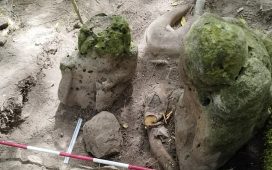The Roman siege of Jewish rebels in Masada, one of the founding myths of modern Israel, may have been far quicker and more efficient and brutal than it has been traditionally represented as, according to new archaeological research.
The end of the AD72-73 Jewish Revolt is conventionally depicted as a heroic last stand against the might of Rome by a handful of rebels who eventually killed themselves rather than be overwhelmed by the emperor Vespasian’s forces.
Situated on a high desert plateau overlooking the Dead Sea, the fortress of Masada was captured by the Sicari, an extremist faction of the Jewish Zealot rebels. It is now one of Israel’s most famous tourist attractions.
The events of the siege were most famously described by the historian Josephus Flavius, a Jewish commander during the war who had surrendered and then befriended the commander of the Roman forces, Vespasian’s son Titus.
Josephus’s account of Masada in The Jewish War – a book published in AD75 – has long been questioned by academics, with some expressing doubt that the mass suicide of about 1,000 Zealots actually took place.
New research suggests a dramatically different version of events. Building on excavations in the 1990s, a paper in the Journal of Roman Archaeology by Hai Ashkenazi, Omer Ze’evi Berger, Boaz Gross and Guy Steibel suggests the besiegers’ strategy – including the construction of the huge siege wall encircling Masada – was a triumph of Roman efficiency.
The researchers estimate that the siege wall could have been completed by the 6,000-8,000 soldiers in less than two weeks, leaving them free to concentrate on building a ramp that ultimately breached the fortress.
The study tallies with previous research that suggested the ramp could have been completed in a month, all pointing to a far shorter timeframe for the siege, which may have lasted two months rather than two years.
“Our workload calculations show that 5,000 men could have built the siege system around Masada in 11-16 days,” wrote the archaeologists, who used drones and 3D modelling to examine the siege constructions and associated camps.
Stiebel, the lead author on the study, told Haaretz: “From the Roman perspective it was not such a big story. It was not like the siege of Jerusalem [which lasted five months and took place in AD70]. They came, they made a precision strike and they left after a few weeks.
“The fact that the siege lasted less time than we thought doesn’t make the site less interesting or less important. It still raises questions that are no less exciting.
“Why did the Romans make this effort, years after the official end of the war, to send 6,000-8,000 soldiers to the middle of the desert? It’s still a huge logistical undertaking. It means it was still very important to them.”
For Stiebel and some other academics, the suspicion is that far from being a show of strength, the reason for the siege was more prosaic: the rebels were threatening the supply of a valuable but long forgotten perfume, balsam, from where it was produced in the nearby wadi at Ein Gedi.











